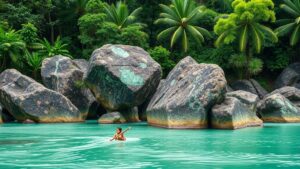Building a Fossil Brand: How to Stand Out in a Competitive Market
Building a Fossil Brand: How to Stand Out in a Competitive Market for Rockhounds and Mineral Collectors
In recent years, the popularity of fossil collecting has surged, driven by a growing interest in geology, paleontology, and natural history. As a result, the market for fossils and mineral collectibles has become increasingly competitive. Whether you are a seasoned rockhound or just starting out, building a distinctive brand can help you stand out in this thriving community. Here, we will explore strategies for creating a compelling fossil brand that appeals to collectors and enthusiasts alike.
Understanding Your Audience
The first step in building a strong brand is to understand your target audience. Rockhounds and mineral collectors come with varied interests that can be categorized into several groups:
- Collectors: Individuals who seek specific specimens to complete their collections.
- Investors: Those who view fossils as an investment opportunity and look for specific types that appreciate in value over time.
- Educators: Teachers and institutions seeking fossils for educational purposes.
- Hobbyists: Casual collectors who enjoy the thrill of the hunt without a specific goal.
Identifying which group or groups you would like to appeal to will inform your branding strategy, product offering, and marketing approach.
Crafting Your Unique Value Proposition
In a saturated market, offering something unique is essential. Consider the following approaches to creating a value proposition that resonates with your audience:
- Quality: Ensure that your fossils are of high quality, well-preserved, and ethically sourced. Approximately 80% of fossil enthusiasts identify quality as their primary purchasing factor.
- Education: Provide educational materials or content that enhances the collectors experience. Informative descriptions about the geological and historical significance of each specimen can captivate your audience.
- Sustainability: Emphasize environmentally friendly practices in sourcing and packaging. A recent survey indicated that 65% of consumers prefer to buy from brands showing a commitment to sustainability.
Establishing an Online Presence
In todays digitally-driven market, a strong online presence is vital for any brand. Here are key steps to establishing your digital footprint:
- Create a Website: Your website should be visually appealing, user-friendly, and contain a seamless e-commerce platform. Include high-quality images, detailed descriptions, and a blog for educational content.
- Use Social Media: Platforms such as Instagram and Facebook allow you to showcase your fossils and connect with fellow enthusiasts. Share behind-the-scenes content, collecting adventures, and fossil care tips.
- Engage with Online Communities: Participate in forums and groups dedicated to rockhounding and fossil collecting. Engaging with these communities helps increase brand visibility and establish credibility.
Leveraging Content Marketing
Content marketing is a powerful way to attract and retain customers. Providing valuable information establishes you as an expert in the field. Consider implementing the following tactics:
- Blog Posts: Write articles about fossil identification, recovery techniques, and preservation tips to educate your audience and boost SEO.
- Videos: Create video content demonstrating the fossil hunting process, showcasing your specimens, or offering tutorials on fossil preparation.
- Newsletters: Regular newsletters keep your audience informed about new arrivals, special promotions, and upcoming events in the rockhounding community.
Network within the Community
Building relationships within the rockhounding community can greatly enhance your credibility and help grow your brand. Here are ways to build connections:
- Attend Trade Shows and Festivals: Participating in events like the Tucson Gem and Mineral Show can provide exposure and networking opportunities. It is estimated that this event attracts over 50,000 attendees annually.
- Collaborate with Influencers: Partner with social media influencers or experts in geology to promote your brand to a broader audience.
Continuous Improvement and Adaptability
The market for fossils and minerals is always evolving. Pay attention to trends and emerging interests such as the growing popularity of crystal healing or unique local geology. Be flexible in your offerings, and don’t hesitate to shift directions based on audience feedback or market dynamics.
Regularly review your sales data and customer feedback to better understand what resonates with your audience. Adaptation is crucial for long-standing success.
Conclusion: Actionable Takeaways
Building a fossil brand in a competitive market is a multifaceted process that requires understanding your audience, crafting a unique selling proposition, establishing a strong online presence, leveraging content marketing, networking within the community, and embracing adaptability. Useing these strategies will not only help your brand stand out but will also foster a passionate community of collectors and rockhounds around your offerings.
With diligence and creativity, you can successfully navigate this exciting market and create a memorable fossil brand that resonates with enthusiasts for years to come.


